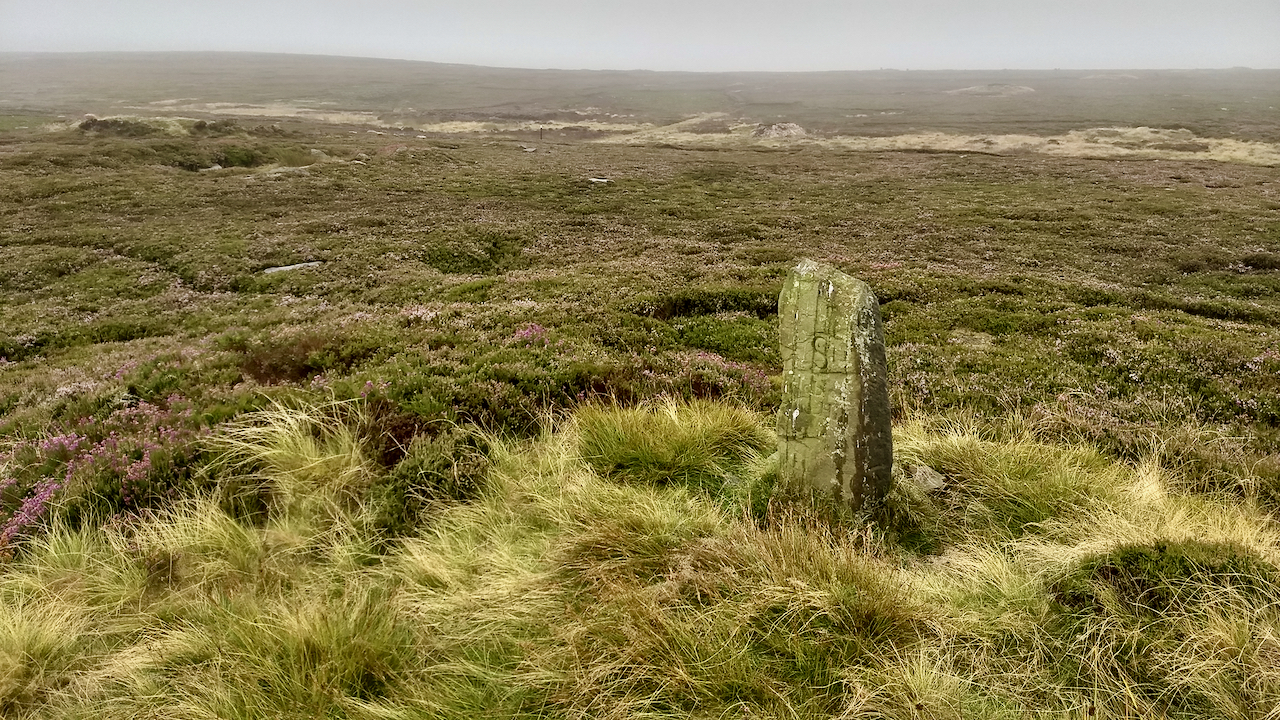A pretty dreich morning. So no scenic photo today, the visibility as I crossed Gisborough Moor being about 50m. Notice the purple is not so vibrant today. Perhaps that could be down to the muted lighting, but it is an intensively managed moorland; I still think that’s a factor.
This boundary stone named as Hob on the Hill was easy to find from the north, using the line of boundary stones that separates the parishes of Guisborough and Lockwood, and to make it even easier a ride had been conveniently mown in the heather.
The stone is inscribed with ‘S HOB ON THE HILL SK’ on one side, and ‘G RC 1798′ on the other. ‘RC’ is probably Robert Chaloner, who had succeeded as Lord of the Manor of Gisborough two years earlier. As for the ‘SK’, a wild guess it may be Skelton. In spite of the date, it is thought the stone may be a much older wayside cross. It stands on top of a Bronze Age round barrow which was partially excavated by the Rev. Canon Atkinson in the 1860s, when three urns containing cremated remains were found1Historicengland.org.uk. (2012). Bowl barrow known as Hob on the Hill and another barrow 60m to the north of it, Guisborough – 1015436 | Historic England. [online] Available at: https://historicengland.org.uk/listing/the-list/list-entry/1015436 [Accessed 15 Aug. 2021]..
The name ‘Hob on the Hill’ is mentioned in earlier document, the ‘Boundary Perambulation 1716‘, when Edward Chaloner2Robert’s great-grandfather, I think ‘perambulated’ around the boundaries of his manor, a legal custom. The name hints at the ancient belief in hobs, troublesome elves or hobgoblins, a belief which is found in other North Yorkshire place-names: Hob Cross, Hob Hole, Obstrusch.
The creatures are found in many parts of the country by other names Hobthrush, Puck, Hogboon, Billy-blin, Boman, Brownie, Master Dobbs, and a name which must have inspired J. K Rowling – Dobby. Whilst we are on literary names I guess I could add Tolkien’s hobbits are obviously derived from ‘hobs‘ too but these of a contrasting character to Yorkshire Hobs, who are generally benevolent and useful around the farm or house if properly treated, but annoy them and they will soon become mischievous and troublesome.
This belief in ‘the little people’ is not confined to Britain. In Denmark and Norway, a ‘nisse‘ was an elf like creature that worked on farms. In Germany, it would be a ‘kobold‘; Sweden: a ‘tomgubbe‘ or ‘tomte‘; a ‘grogan‘ in Ireland, so too, of course, leprechauns; and in Holland: a ‘redcap”. All slightly differing characters and temperament.
You’ll all be pleased to know, no hob popped out to guide me across the moor today.
- 1Historicengland.org.uk. (2012). Bowl barrow known as Hob on the Hill and another barrow 60m to the north of it, Guisborough – 1015436 | Historic England. [online] Available at: https://historicengland.org.uk/listing/the-list/list-entry/1015436 [Accessed 15 Aug. 2021].
- 2Robert’s great-grandfather, I think

Leave a Reply